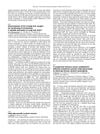EtG Quantification in Hair and Different Reference Cut-Offs in Relation to Various Pathologies: A Scoping Review
November 2022
in “
Toxics
”
TLDR EtG in hair can help detect alcohol use but may be inaccurate in people with certain health conditions.
This scoping review explores the use of ethyl glucuronide (EtG) in hair as a marker for alcohol consumption, particularly in individuals with liver and kidney diseases, diabetes, and transplant recipients. It highlights that these conditions can affect EtG levels, leading to potential false positives or negatives. Renal dysfunction can cause high EtG concentrations due to delayed excretion, complicating alcohol consumption interpretation. The review emphasizes the need for careful consideration of these pathologies and calls for further research to refine EtG testing methods and establish accurate cut-off levels. Despite limitations, hair EtG testing can improve alcohol consumption detection, especially in liver disease patients, with varying sensitivity and specificity based on disease severity and cut-off levels.



